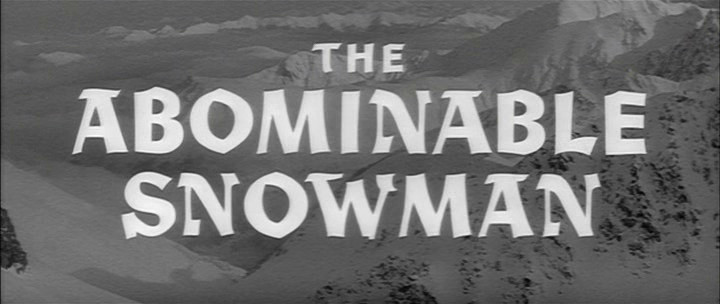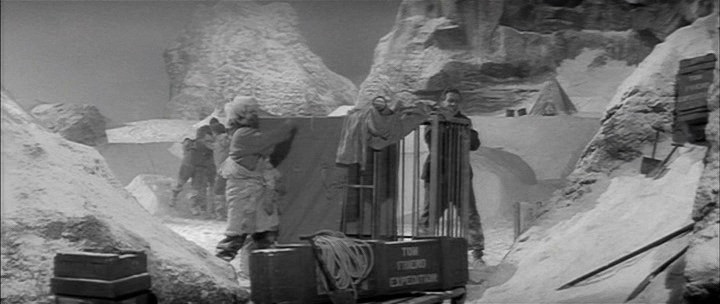Director: Val Guest
Writer: Nigel Kneale, from his own screenplay for The Creature
Stars: Forrest Tucker and Peter Cushing
 |
Index: 2019 Centennials.
I’m personally valuing my centennial review choices not only because they allow me to discover new favourites through research but also because they allow me to revisit old friends in much better circumstances. For instance, I’ve seen The Abominable Snowman before, but not in the last three decades and not in pristine Hammerscope. I probably last saw it as a teenager on a small black and white television, emphatically not the best way to see anything. Then again, Nigel Kneale based his script on a screenplay that he’d written for The Creature, a 1955 episode of BBC Sunday-Night Theatre, that nobody, as far as we know, has ever seen on anything but a small black and white television. That’s because it was broadcast live from Lime Grove Studios, with a repeat four days later, also broadcast live. No recording is known to exist and one may not have been made, though some similar broadcasts around this time were telerecorded and the oldest to survive, the first two episodes of The Quatermass Experiment, were written by Nigel Kneale.
Like The Quatermass Experiment, The Creature was produced and directed by Rudolph Cartier, who worked with Kneale often; they’d made three serials about Prof. Bernard Quatermass and a 1954 adaptation of Nineteen Eighty-Four. Television was primitive back in the early to mid fifties but Cartier and Kneale kept pushing the envelope forward. The Quatermass Experiment, in 1953, was the first original British science fiction show produced for adults. Nineteen Eighty-Four was accompanied by a live orchestra performing one studio over, watching the production as they played on a closed-circuit screen; questions were asked in Parliament about whether the BBC should broadcast such “horrific”, “subversive” material, and on a Sunday no less. The Creature brought the outdoors into the studio with a great deal of exterior footage previously shot in the Alps being projected behind the actors. Quatermass II in 1955 also benefitted from some filming on location and was telerecorded onto 35mm film, so that it could be easily re-broadcast.
 |
Of course, the film industry was paying attention, even though it was used to much higher budgets and production quality, as well as multiple takes, editing and post-production, none of which was possible on live television broadcasts. Hammer Film Productions had already bought the rights to the first two Quatermass serials and adapted them to film and it did the same with The Creature, the title being changed to The Abominable Snowman and, to clarify to American audiences, The Abominable Snowman of the Himalayas. The films were all British productions with predominantly British cast and crew, but with an American co-producer, Robert L. Lippert, who provided an American star in return for the rights to distribute them Stateside. For the two Quatermass pictures, that star was Brian Donlevy; for The Abominable Snowman, it was Forrest Tucker, who would have been one hundred years old today and who had acted for Hammer before. He shared top billing with Peter Cushing, who reprised his role from The Creature.
Tucker was certainly the bigger star at the time, although the work for which he’s best known today was still to come. He’d shifted over from vaudeville to film in 1939 and his debut came a year later in The Westerner, in which he fought Gary Cooper, who at 6’ 3”, was still an inch shorter than he was. He quickly worked his way up the credits, appearing in both a Lone Wolf and a Boston Blackie movie for Columbia and major pictures like Keeper of the Flame and The Yearling while on loan to MGM. Moving to Republic, he made a string of westerns and war pictures, including lead roles in California Passage and Rock Island Trail in 1950. He supported Margaret Lockwood in a couple of British pictures and joined Hammer for a spy thriller called Break the Circle, directed by Val Guest, who also directed him here. He stayed on for a couple more Hammer sci-fi features, The Strange World of Planet X and The Trollenberg Terror, a picture much better known today by its American title of The Crawling Eye. He was almost a Hammer regular!
 |
I focus on both of them here because The Abominable Snowman really needs both of them to work. They’re very different characters, who see their shared goal very differently. As the film runs on, those differences grow and, frankly, define the film for me. We meet Cushing first, as an intelligent British botanist by the name of Dr. John Rollason. He’s leading an expedition to the Himalayas to seek out new rare plants for their medicinal value, as funded by a botanical foundation. We meet him at a Buddhist monastery, where he has found a good rapport with the local lama, who fortunately speaks English, even though it’s with a notably German accent, given that the actor playing this Tibetan holy man is Arnold Marlé, who was born in Berlin. Incidentally, like Cushing, he reprised his role from The Creature, as did Wolfe Morris, a British actor of Ukrainian/Jewish heritage, who plays a local Tibetan guide, Kusang. These casting choices are hardly appropriate, but I wonder how many Tibetan actors there were in London in 1957.
 |
Of course, the five soon set off up the slopes, because without that we wouldn’t have a movie, and the further they go, the more we and Dr. Rollason discover about Friend’s actual motives and just how prepared he is to satisfy them. For instance, he doesn’t merely want to find an abominable snowman for “the pursuit of knowledge”, justifying what Helen calls her husband’s “theories about the high valleys and what might be there”, he wants to catch one and take it back home alive to exhibit. That’s why one of the party, Ed Shelley, is an expert trapper. The other is a photographer, a Scot named McNee who paid his way onto the trip and wouldn’t be on the party without it. Friend’s previous and much more obvious expedition left caches of food at stopping points up the mountain, a logical approach when planning for a later smaller expedition that might not scare off the yeti, but it left weapons and traps as well. And it doesn’t take long for us to find out that Friend’s history of showmanship includes “wolf children” in freakshows.
 |
I remember director John Carpenter on a British TV show talking about this sort of cultural difference. He framed it in the terms of right wing horror and left wing horror, suggesting that right wing horror is a mindset of “It’s out there, it’s gonna get me,” and left wing horror is “It’s in me, it’s gonna get me.” In those terms, the Americans, led by Tom Friend, are clearly right wing horror. Each time they hear a noise, they clamber out of their hiding places with their guns, ready to defend themselves and to take down a yeti. Rollason, however, is just as clearly left wing horror. He theorises not only that these mysterious creatures might be a third branch of evolution, alongside men and apes, but that they might be waiting high up in the Himalayas for mankind to destroy itself so that they can emerge as the next hope. Friend and Shelley see the yeti as the monsters. Rollason sees the members of this expedition as the monsters in a sort of Beauty and the Beast scenario. We might expect the Beast to be, well the beast, but maybe everyone else is.
 |  |
The mountains that viewers saw on screen in The Creature were the Swiss Alps, but the mountains here are the French Pyrenees. A ten day shoot took care of the majority of the background, using a clockwork camera and an anamorphic widescreen format called Regalscope, which Hammer naturally renamed Hammerscope. This was mostly done on a mountain named Pic du Midi de Bigorre, as well as from a helicopter and often from a cable car. It’s gorgeous stuff and it seems strange to discover that Arthur Grant, on his first film for Hammer, was known for being fast and cheap rather than steady and artistic. This footage clearly includes five people on the mountain but, of course, it wasn’t the actors, just doubles. When we see the actors, it’s generally on capably constructed sets and in believably impenetrable artificial snowstorms. I particularly liked the wind. Sometimes we hear it roil around the characters but sometimes we see it dominating everything around it in those snowstorm scenes.
 |
Of course, most people today remember him for his work on television. Sure, he continued on the big screen, with memorable roles in pictures as different as The Night They Raided Minsky’s, Chisum and Thunder Run. And sure, he continued on stage too, but nothing cemented his fame with the public like the 1966 television show, F Troop. It only ran for two seasons but it stayed in syndication far more than other shows he made like Crunch and Des, Dusty’s Trail and The Ghost Busters, whose single year run included an episode I should seek out entitled The Abominable Snowman. Oddly, given the prominence of television in his career, at least to the minds of a 21st century audience, his star on the Hollywood Walk of Fame is for motion pictures. I’m not expecting they gave it to him for this film, but it highlights how he always did the job at hand, whether it be comedy, action or simply the wrong side of a morality play. Sadly, Tucker, suffering from lung cancer, collapsed on his way to his star ceremony in 1986 and died a couple of months later.
Key Bibliography:
Oliver Wake - The Creature (1955)



No comments:
Post a Comment